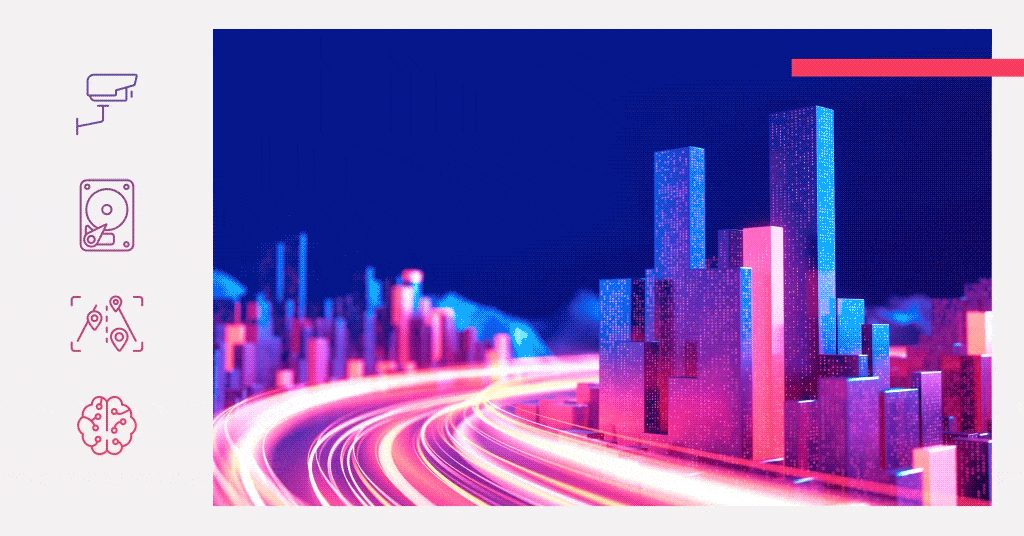Traffic is inescapable for millions of people around the world. Whether it’s the morning commute or the weekend escape, the gridlock of tires and tarmac is a constant, and the societal impacts are clear. Americans lost 99 hours a year in 2019, and collisions are the leading cause of death for Americans aged one to 54. Economists estimate that traffic related accidents are projected to cost the world economy $1.8 trillion by 2030 and that traffic causes an increase in greenhouse gas emissions such as NO2.
But, it may not have to be. Thanks to advancements in several tech fields, a reimagining of how we manage transportation is on the horizon. Powered by smart cameras, computer vision, and robust storage solutions, Intelligent Transportation Systems (ITS) around the world are part of a smart city movement.
What is ITS and what does it do?
In short, an ITS is an advanced application of sensors, cameras and recorders that use AI algorithms and deep learning to autonomously manage transportation. This can be anything from metering onramps to intelligently changing traffic patterns so that pedestrians can cross the streets. While in the past this could have been done by having a human oversee the video feeds and dispatch work orders from a hub, today it can be accomplished with AI empowered cameras.
Brian Mallari, director of product marketing, Surveillance & Smart Video for Western Digital, explained in an interview that, “the intelligent portion [of the system] is to analyze the video data.” Training the AI to recognize a pedestrian as a pedestrian, a bike as a bike — and so on — is crucial to the system. In the past, the analyzing of data was only possible at a centralized location (like a data center), but with the rise of on-board AI chips Mallari believes that implementation of smart city technology will begin distributing the analytical load.
“Smart cameras will do the work on site, then send the results to a central location,” said Mallari. “At a smart city scale, it’s so distributed … so it’s important to spread out the work.”
For a real world example, Mallari highlighted the North Avenue Corridor in Atlanta, which demonstrates many of the capabilities of a modern ITS: AI empowered devices, autonomous responses, and others.
Storage advancements that drive the sector forward
As a leader for the WD Purple brand, Mallari’s work focuses on smart video implementation of data, and realizes that more robust storage solutions are needed for this rising industry of smart city technologies. As a result, WD Purple™ Pro was introduced to meet rising demand from deep learning systems and the AI-training solutions that power the smart video industry.
Mallari highlighted that the smart video sector is in the middle of a transitional phase for video recording at scale. Before it was just recording raw data from a “dumb” camera, and in the future more of the storage and analysis will be done on the AI-camera. “Purple Pro is still designed for server-side implementations, but is ready to power the AI advancements,” he said.
The new line of HDDs and other storage solutions boast the ability to record up to 64 HD streams simultaneously, while improved workload and performance enable the drives to keep up with the demands of AI functionality, including pattern matching and object recognition. The idea behind this line of devices is to combine video stream recording optimization with top tier durability and capacity to ensure that drives stay healthy for thousands of hours of video recording an analytics.
What’s the impact?
While ITS implementations are still nascent, there are some early signs that suggest they’re worth the investment for both businesses and municipalities. A joint study from Temple University, the University of Houston, and the London School of Economics found evidence for substantive economic and time saving benefits. Their research found that ITS systems could recover 175 million hours of travel a year, prevent 53 million gallons of fossil fuel consumption a year, and reduce CO2 emissions by 10 billion pounds a year.
The Brookings Institute suggests similar benefits for the economy. In a paper, the research organization estimates that automated vehicular systems might save Americans $507 billion in productivity and $488 billion in accident reduction. Moreover, they estimate that there may be a $2.5 trillion dollar impact worldwide as a result of the adoption of smart mobility services.
The economic, public health, and environmental impacts of Intelligent Transportation Systems could be immense, and the innovations that stand at the forefront of the field are equally meaningful. The ultimate goal, however, is to improve quality of life across a city. As Gene Leyzarovich, President/CEO of ACNC QSAN, said in the “For a Smarter World” virtual event, “the common factor among all smart city projects is their common goal to improve livability for their citizens.”
But, perhaps more importantly, these systems are a testament to the industrious and imaginative future of our cities. ITS and similar smart city developments empower city panners, engineers, and designers to imagine new cityscapes for the cosmopolitan cosmonaut. Indeed, data can lead us to an era of walkable cities, hyper efficient transportation, and renewed centers of commerce and culture that are closer, cleaner, and more connected than ever.



